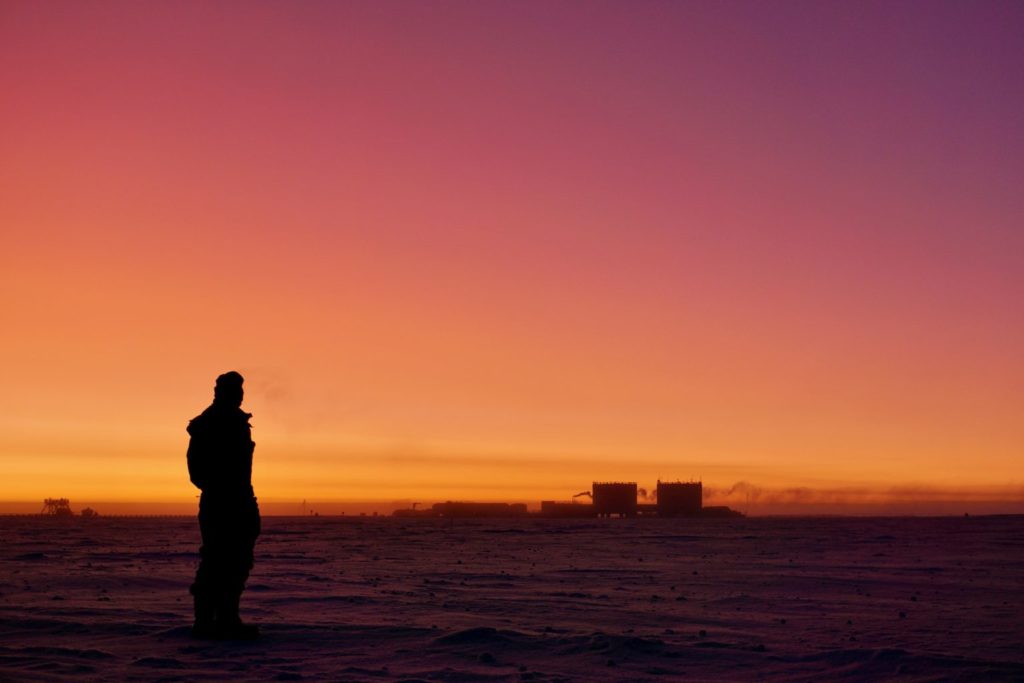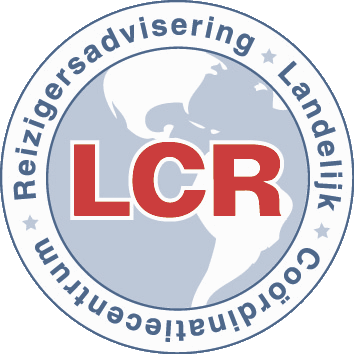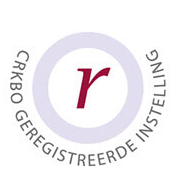Stijn Thoolen has been selected by the European Space Agency (ESA) to research Concordia, Antarctica from November 2019 up to and including the beginning of 2021. We occasionally receive an update from Stijn about his findings on this small, isolated part of the world. Today, a proper long read, the eight-piece: where he tells us about the research he is conducting!
Concordia, July 28, 2020
Sunlight: none, but the skies are turning colours again!
Windchill temperature: -83°C
Mood: some days a little tired, and on others, like the skies, full of colour
If you have read my previous posts, you have probably had enough of the beautiful-environment-and-working-together-drivel, and I am guessing you now think something along the lines of: weren’t you supposed to do space research?
Good question, and it makes me realize that perhaps it is time for something more interesting: science!
But I am not sure if an ESA blog can go without any music, so before we continue here is a nice tune to walk you through: Spirit In The Sky- Norman Greenbaum.
Part 1: Altitude problems

I already mentioned what a science-heaven Concordia is. From palaeoclimatology to geophysics to astronomy: science is the whole reason that this station exists. But while most of it focuses on the unique environment we currently live in, ESA is rather interested in us living in this unique environment! Both the Antarctic and space are domains that we, humans, have started to explore only recently, and the mismatch between our ancient bodies and these new extreme environments poses the ultimate challenge to our system. How adaptable are we? Where lies the limit of our human resilience? What are the risks to our physical and mental health when we venture to these strange places, how does that impact future space travel, and are there ways to mitigate those risks? So, rather than the environment itself, it is our interaction with it that I find particularly interesting.
Take, for example, the altitude. Here in Concordia, we live at an altitude that is equivalent to about 3800 meters above sea level at the equator. As such, the air contains about 40% less oxygen for us to breath, and you definitely feel that when you arrive here by plane. Low energy, panting with the slightest exercise, waking up gasping for air multiple times a night, headache, dizziness, loss of appetite. Some really get sick from it, and in rare cases, people have to be sent back to the coast due to life-threatening build-up of fluid in the lungs or brain! Yet, in 1978 Messner and Habeler reached the summit of Mount Everest at an altitude of 8848 meters without using any supplemental oxygen at all. How? They allowed time for their bodies to adapt.
At Concordia, it usually takes a few days before you feel better. As your body senses a decrease in oxygen pressure, it immediately tries to save your cells from getting damaged by sucking in more air (breathing) and pump more oxygen through the body (by increasing heart rate), and subsequently starts up a remarkable cascade of physiological processes that eventually leads to increased production of red blood cells. As a result, the composition of our blood can drastically change over weeks, to help deliver sufficient oxygen to each of our cells. Pretty cool, don’t you think? Even though after eight months, I still find myself hyperventilating up the stairs and having miserable nights every once in a while, at least it allows me to go to beautiful places like Concordia!
The adaptation, however, comes with a trade-off: if the need for oxygen-carrying capacity of the blood is too high (at higher altitudes, where there is less oxygen) and too many red blood cells are made, the blood can become so thick that it increases the risk of blood clotting, high blood pressure in the lungs, and even heart failure! Such health issues have been seen in some people living permanently at high altitude. So how healthy actually is a year of adaptation at Concordia? Knowing that similar low oxygen conditions may exist in future space habitats for technical, economic and safety reasons, and considering the simultaneous blood volume alterations usually seen as an effect of microgravity, answering that question is important to understand astronaut health and safety during future long-duration space missions.
The ANTARCV study (‘alterations in total red blood cell volume and plasma volume during one-year confinement in Antarctica: effect of hypoxia’) is implemented this year to do so. Each month the crew comes to the ESA lab for a lucky treatment of vein punctures, and an awkward procedure of breathing a very small and safe dose of carbon monoxide through small, restrictive tubes. This way I can determine our blood volumes. Besides I analyze how thick our blood is, store blood samples for further analysis in Europe, and we all wear a watch one week a month to record our activity. That way we make sure that the changes we see in blood volumes are not just a result of changes in physical activity. You can understand the crew loves me for it…
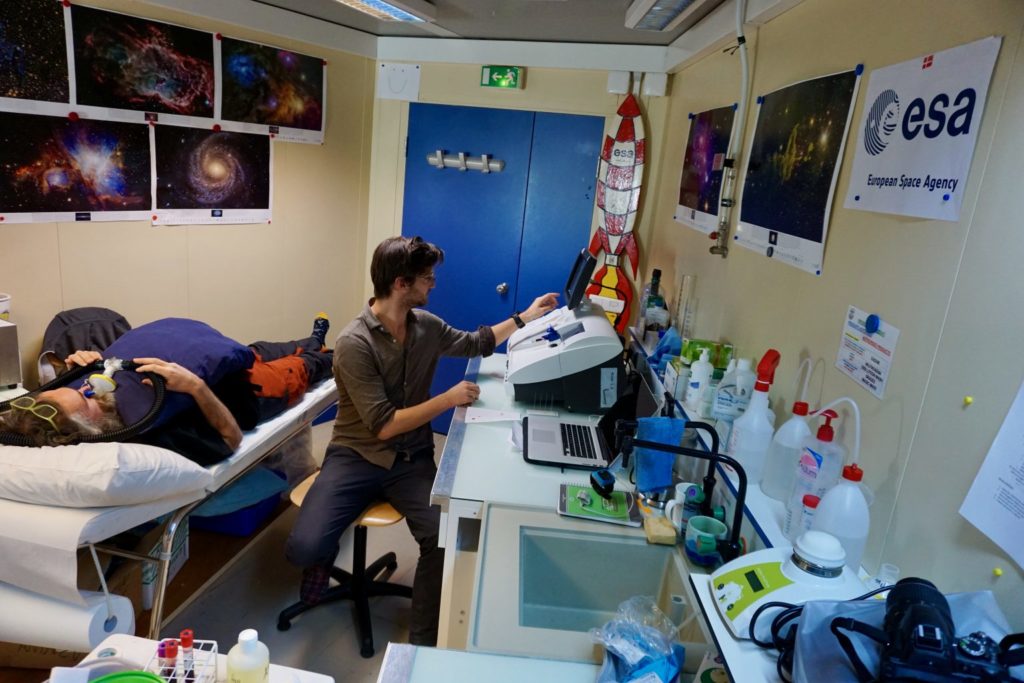
Still, all of us are participating in the research, and that is awesome! You see, doing human research here can be quite a challenge, not only because of language barriers, limited data transfer possibilities, or complex transportation logistics, but mostly so because the participation in these experiments is entirely voluntary. None of us works here primarily to serve as a test subject, and it is not that I can force anyone really… So to make sure I come home after a year with sufficient interesting data, I better make sure that everyone is happy with what we are doing here. For me perhaps a tricky mix between work and private life, but all for the good cause of science! After all, who doesn’t want to be part of the space program, bring benefit to future hivernauts and astronauts, and on top of that help to understand the health challenges of our present-day society?
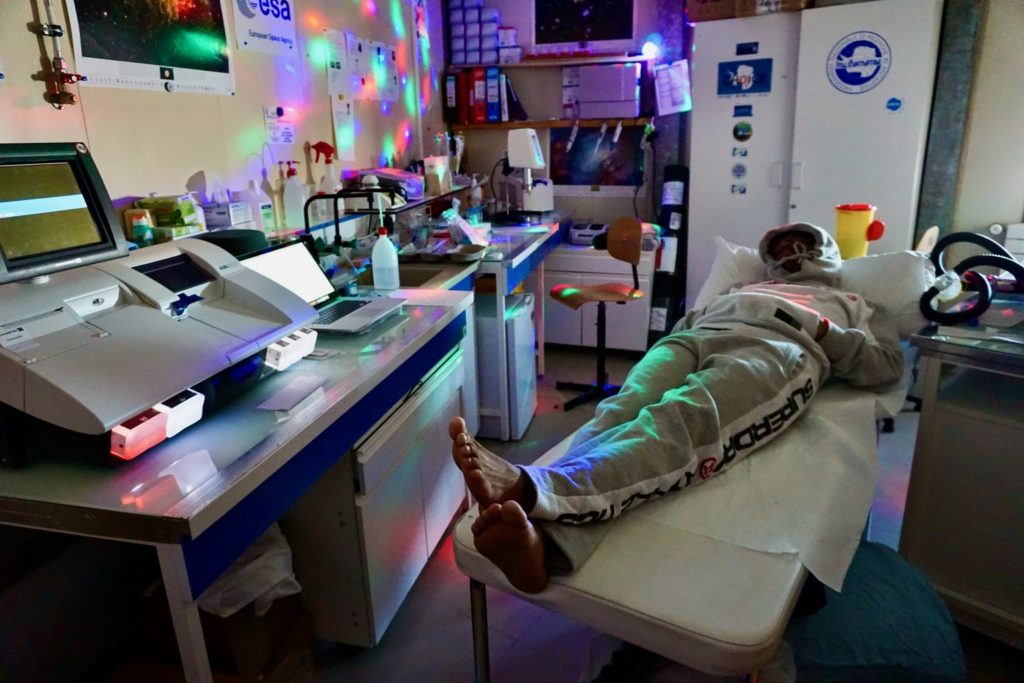
Part 2: Immunity and Hygiene
And so we keep delivering. Questionnaires about stress, physical and mental wellbeing, questionnaires about nutrition habits, stool samples, saliva samples, blood samples, taste tests with taste strips, smell tests with ‘Sniffin’ Sticks’. I make pictures of what I am eating twice a day, and our cook records our menu a whole year long. And, perhaps best of all, we all take a sachet every day, without even knowing if it contains a probiotic supplement or nothing but just powder…
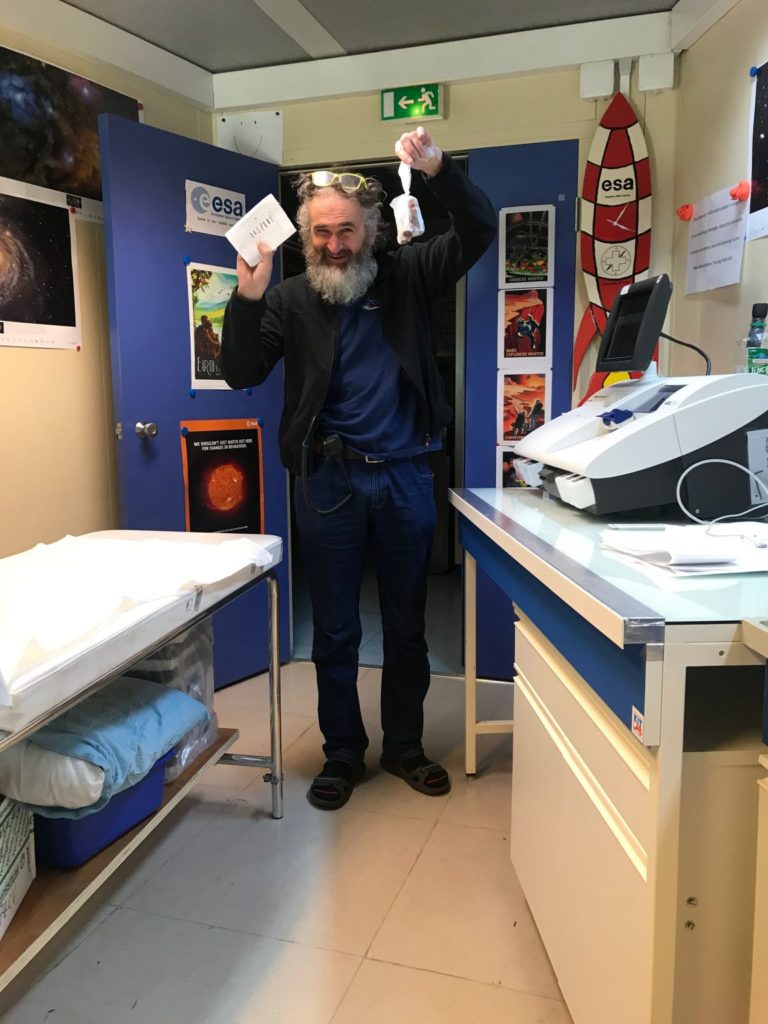
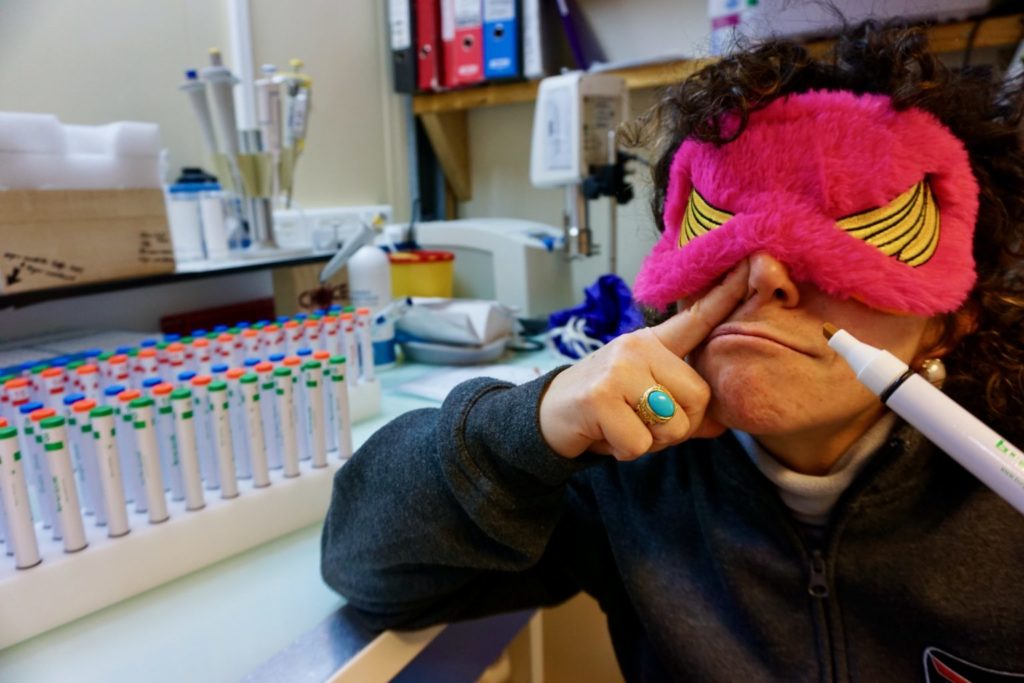
This time the tests are for another study called ICELAND (‘immune and microbiome changes in environments with limited antigen diversity’). ICELAND doesn’t focus on altitude but instead uses the homogeneous environment of Concordia, another stressor to our body and mind, as a testbed for examining changes in immune health. Have you ever thought of the idea that, just like in Concordia or in space, a lack of new bacteria and viruses can actually deteriorate your immune system? Have you ever considered that we may be too hygienic? Just like losing muscles when we spend too much time on the couch or losing skills if we don’t practice our brain, we can lose immune function when it is not stimulated, and according to the ‘hygiene hypothesis,’ this may be one of the reasons for an increased incidence of asthma and skin inflammation in children in developed countries. In a similar way, prolonged isolation and confinement in the stressful and ‘clean’ environments of Antarctica or space is thought to increase susceptibility to infections and even allergies!
But the immune system is complex, and the many interactions it holds with other body systems such as our digestive system and our brain are just being discovered. For example, changes in nutrition can have an effect on the composition and health of our gut bacteria, which in recent years have been found to play an important role in the development of immune-related diseases such as allergies and cancer. Other studies, in addition, have found gut health to be related to mental wellbeing as well. So can we maintain a healthy brain and a healthy immune system if we maintain a healthy gut? We still have much to learn about ourselves, and ICELAND aims to investigate these interesting interactions. Hence those daily sachets: comparing the test outcomes between those of us who took gut bacteria-stimulating probiotics and those who didn’t can give us valuable information about its potential to counter these health risks!


Part 3: Mindfulness
Fortunately, it is not all body fluids (and solids) in the ESA lab. Other projects are more interested in the psychological adaptation to space-like environments. How do we deal mentally with the isolation far from home, the confinement, monotony, and life in a small international crew? The experiences and stressors that crews face during such missions require a certain degree of mental resilience, or may otherwise result in cognitive or behavioural problems and a loss of performance that can be dangerous to both the crew and the mission. To facilitate such psychological adaptation and resilience, the scientists behind MINDFULICE (‘role of mindfulness disposition in an isolated and confined environment’) for example are investigating the use of ‘mindfulness’ as a tool for deep space missions.
‘But isn’t that something for Buddhist monks?’, I hear you question…
I actually like to think it is quite the opposite. And although maybe it isn’t an easy construct to grasp, we are all already mindful to a certain degree. Perhaps it is best to think of it as a mental process, of being aware in the present moment, welcoming what is new with the intention of kindness and compassion, and being open-minded enough to see new possibilities in any given situation rather than relying on what you have previously learned. Everyone does that to a certain degree, but everyone can also learn to do it more.

Perhaps that is the biggest reason that the concept is gaining so much popularity so quickly. In our stressful and busy lives, mindfulness helps us to see solutions rather than problems, and research has already demonstrated many of its benefits, spanning from health and wellbeing to even business and artistic endeavours! A mindful attitude has shown to reduce stress while increasing resilience, task performance, enjoyment, psychological and even physical wellbeing, and in general, a higher quality of life. That, I would say, is the promising power of the mind!
So can mindfulness also help astronauts to cope with the harshness of a deep space mission? We like to think so, but to find out, we must first understand how it relates to stress and psychological wellbeing in such conditions, and Concordia serves as the ideal testing ground. Of course, that means more tests for us, so over the year we fill in questionnaires and perform attention tasks to determine how mind- and stressful we actually are. And how about you? Are you mindful enough to one day float to the stars?
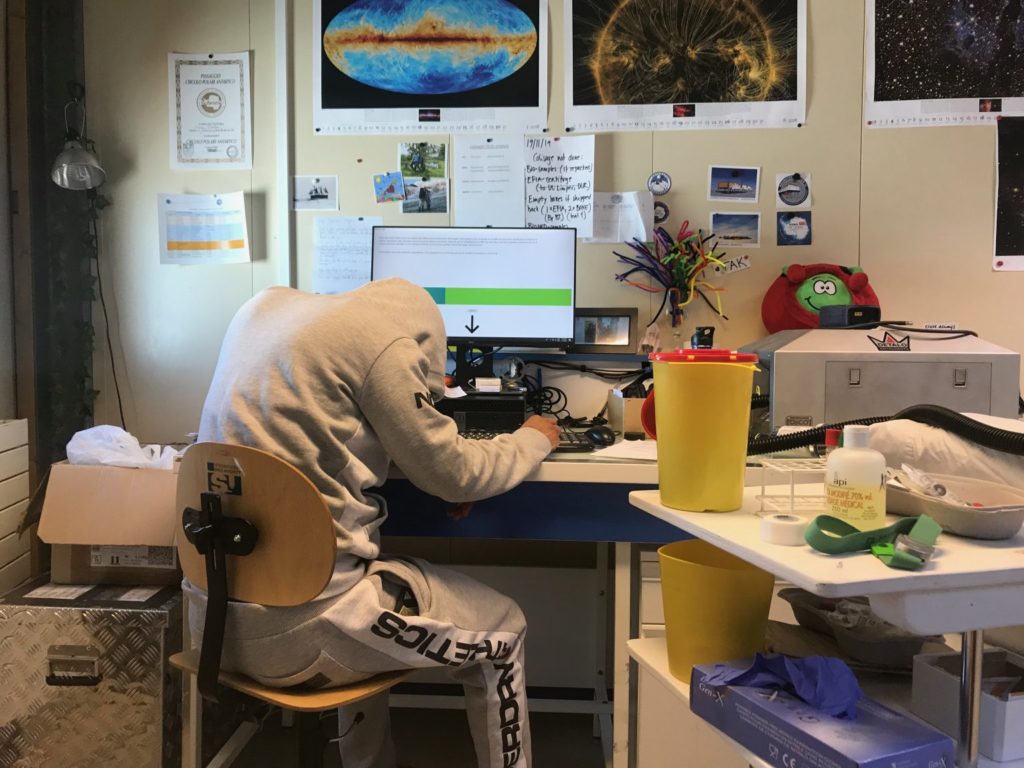
Part 4: Sex
But there is more to the ESA lab, and I have saved the best for last. So, now that you are probably overloaded with theories and facts let’s talk about something very different. Let’s talk about sex!
And before we continue, you have to promise me to turn on another song, to end this blog with some appropriate groove: Sexual Healing – Marvin Gaye.
So, sex at Concordia… Well, to tell you the truth, there doesn’t seem much to it. At least I haven’t seen it. Maybe there has been more excitement in other crews, but with my girlfriend, on the other side of the globe I couldn’t agree more with the wisdom of Apsley Cherry-Garrard, a member of the famous and ill-fated Terra Nova expedition to the South Pole in 1910-1913:
‘Both sexually and socially the polar explorer must make up his mind to be starved.’
But maybe there is more to it than it seems, and what Cherry-Garrard says is not necessarily easy to do. We are human, after all. Sexuality is one of our core features, vital for our existence, and for many, it is a fundamental source of pleasure, intimacy, bonding, and social relations. Researchers have shown how sexual deprivation can lead to frustration, anger and even depression, and also seen from a group perspective anecdotal accounts have shown that sexual desire and related feelings of jealousy and competition can lead to adaptation problems in extreme environments. Including Concordia!
But the problem with sex it that we don’t easily talk about it. Perhaps it is so close to our core that opening up about it can make us feel vulnerable. A sensitive topic, and while researchers are currently busy figuring out how to compose future space crews in terms of culture, personality and gender, data about sexual behaviour and its effects on team dynamics in extreme environments is basically non-existent! How do we cope? How, why, and when do we suffer? Recent political debates and scandals of sexual harassment have already highlighted the importance of having a work environment free of sexual hostility, and if you ask me, it would be irresponsible to send humans on a multi-billion dollar long-duration mission to Mars without being able to answer these questions!
As such, the project SWICE (‘sexual wellbeing and sexual security in isolated, confined and extreme environments’), for the first time in spaceflight research history, is breaking the taboo. As the first study of its kind, it aims to gather basic information about human sexuality while living in isolation and confinement, and it does so by making us in Concordia talk:
‘How often does another Concordia inhabitant asks me for sexual favours?’ (we better forget the jokes at the dinner table…), ‘How often does another Concordia inhabitant produces sexually explicit graffiti for display at Concordia?’ (we better forget the sexually explicit Play-Doh creations we made with the whole crew last month…), ‘How enjoyable is your sexual life right now?’, ‘How often do you masturbate?’, ‘How often do you experience an orgasm?’ (Damn, you want to know everything!).

We had a structured anonymous interview (you know, like in the movies, with voice distortion and stuff) before we came here, and we will repeat it upon our return to Europe. Meanwhile, here in Concordia, we fill in questionnaires throughout the year that look much like the above. And to make sure that everyone feels safe and confident to provide such sensitive data, and as I don’t want to know how the others here spend their free time, we all got an iPad to send the data directly to Berlin. This way, everything stays anonymous. Still, answering these questions are good for a solid lesson in shamelessness, I would say! Everything for a safer, healthier, and more successful environment, and again, for the good cause of science!
And with that, I think you have heard enough ESA lab, and enough material to ponder upon. So now you know a little more about the challenges that we face here and what keeps me busy so far from home, I can only encourage you to appreciate the things we sometimes miss here and enjoy the environment you interact with. Take a deep breath of oxygen-rich air, get yourself dirty every once in a while, find some fresh food, explore the beautiful and ever-changing world around you!
